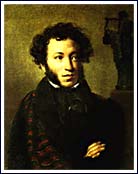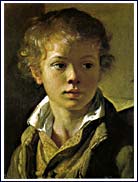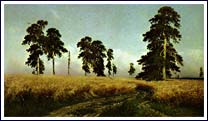Form
in Russia
The Tretyakov Gallery

by Orest Kiprensky.
Portrait of Alexander Pushkin
The Tretyakov Gallery dates from 1856, when the purchase of Nikolai Schilder's painting The Temptation saw the beginning of the collecting activities of the young, wealthy Moscow merchant, Pavel Tretyakov (1832 - 1898). Whereas his first acquisitions followed no clear pattern, paintings by Vasily Perov, added to the collection in the sixties, determined paths which the Gallery was to follow. There was to be a collection of Russian painting, the fulfillment of a historic mission - that of patriotic and moral education of the people.
Pavel Tretyakov acquired the very best from contemporary painters in Moscow and St Petersburg. The collection contains many works by members of the Society for Circulating Art Exhibitions (The Peredvizhniki). Often taking part in the selection of pictures were such outstanding painters as Ivan Kramskoi and Ilya Repin, the critic Vladimir Stasov and other Russian cultural figures; this turned Tretyakov's collection into a veritable center of Russia's artistic life.
The collector's brother, Sergei Tretyakov, was also a connoisseur of art who collected pictures not only by Russian, but also by French and Dutch painters. The Tretyzakov brothers' mansion in Lavrushinsky Lane had to be expanded in 1872 to accommodate the two collections. Subsequently, rebuilding had to be undertaken five times. Six more rooms had to be added in 1882 to accommodate the vast Turkestan series of paintings by Vasily Vereshchagin. The modern facade of the Gallery was added to the Tretyakov's mansion in 1902 from a design by Victor Vasnetsov.
The collection of Pavel and Sergei Tretyakov was opened to the public in I874 as a private museum and rapidly became very popular.
In 1892 Pavel Tretyakov presented his collection, by that time already famous, to the city of Moscow.

by Vasily Tropinin.
Portrait of the Artist's Son
In 1917 the collection numbered 4,060 items. By the Decree of the Soviet government of June 3, 1918, signed by Lenin, the Gallery was nationalized. From a municipal museum, the Tretyakov Gallery was transformed into a state museum. In the twenties the Gallery was enlarged through the addition of the collections of the major Moscow collectors I. Ostroukhov and I. Tsvetkov, S.Shcherbatov, of paintings from the Historical Museum and works of art from palaces, estates and churches. During those years paintings by Western Europeans, mostly Dutch and French masters, were transferred from the Tretyakav Gallery to what is today the Pushkin Museum of Fine Arts. This made the collection of the Tretyakov Gallery more uniform and altered its structure. During the thirties the growth of the collection made it necessary to build another 16 new halls, which doubled the area of the former building. The most spacious hall was designed to accommodate the painting The Appearance of Christ to the People by Alexander Ivanov. This huge canvas, which marked a whole stage in the history of Russian painting, was handed over to the Gallery together with a rich collection of the painter's studies and sketches from the Rumiantsev Museum. At the same time, the Gallery received a number of works by Russian sculptors of the late 18th and early 19th centuries which started the beginning of a Department of Sculpture.
Pavel Tretyakov also started a collection of Russian graphic art.
Also, in the Department of Russian Icons, one can see the famous Old Testament Trinity, the only work authentically attributed to Andrei Rubliov. Its subject is borrowed from the Old Testament story of the appearance of God to Abraham and Sarah in the image of three travel weary angels who asked for shelter. Rubliov depicted the three angels as an embodiment of the concept of spirituality.

by Ivan Shishkin.
The Corn
The Old Testament Trinity was considered to be the main icon of the TrinitySergius Monastery at Zagorsk;
the chronicles certify that Andrei Rubliov was its author (like all icon-painters of his time, Rubliov never signed his works). Another masterpiece attributed to him with rather a high degree of certainty is a series of icons for the iconostasis of the cathedral near the town of Zvenigorod, not far from Moscow.
The Gallery possesses outstanding Russian paintings of the 16th century, including icons attributed to Dionysius. The department's display concludes with works by the 17th century icon painters of the Kremlin Armory headed by Simon Ushakov.
In 1912, the museum was opened to the public. Now Moscow had a comprehensive collection of copies of ancient Greek, Roman, medieval and Renaissance masterpieces, including electroplate copies of some of the best-known silverware antiquities. In addition to that, the museum found itself in possession of a remarkable co11ection of Egyptian antiquities and several 13th and 14th century Italian paintings.
The Museum of Fine Arts functioned as an educational center under the auspices of Moscow University until 1923, when it was handed over to Narkompros (The People's Commissariat of Education) as a national museum. The new status required essential changes in the structure and work of the museum.
In the early twenties, the museum already housed a substantial collection of paintings. These at first included Dutch and French paintings from the Tretyakov Art Gallery collection as well as French and Flemish paintings and several Rembrandts from the collection of the abolished Rumiantsev Museum.
Gradually the Museum of Fine Arts, from a collection of replicas, turned into a repository of original artistic masterpieces. It was named after Pushkin in 1937 (the centenary of the poet's death).
In 1948, the museum collection grew again, to include the late 19th and early 20th century French paintings and French sculptures of the same period from the abolished Museum of Modern Western Art. This provided a link with modern art.
Fiancee Visas!
Fast - Full Service
 Let A Foreign Affair and Attorney Jones handle all your Fiancee Visa and Immigration matters
Let A Foreign Affair and Attorney Jones handle all your Fiancee Visa and Immigration matters
- Faster Overall Processing
- 100% success rate
- Fluent in English and Russian
- Vice Chair of the Immigration Section of the State Bar of Az
www.fiancee-visa.com

Join Our
Hair Health Romance & Vacation Tour!
Take a wonderful and romantic vacation to the foreign destination of your choice, enjoy meeting hundreds of beautiful marriage minded women and obtain the hair loss restoration, replacement, transplant or treatment of your choice.
Restoration of hair loss or treatments to stop hair loss have never been so much FUN for men world wide!
hairtransplanttours.com
Welcome to A Foreign Affair!
View thousands profiles with photos of beautiful and marriage minded Russian, Ukrainian and Latin women.
Join our unforgettable Romance Tours to Russia, Ukraine or Latin America and meet 500 to 2000 Beautiful Foreign Women.
A Foreign Affair offers more Romance Tours to more cities than any other tour company.
www.loveme.com



